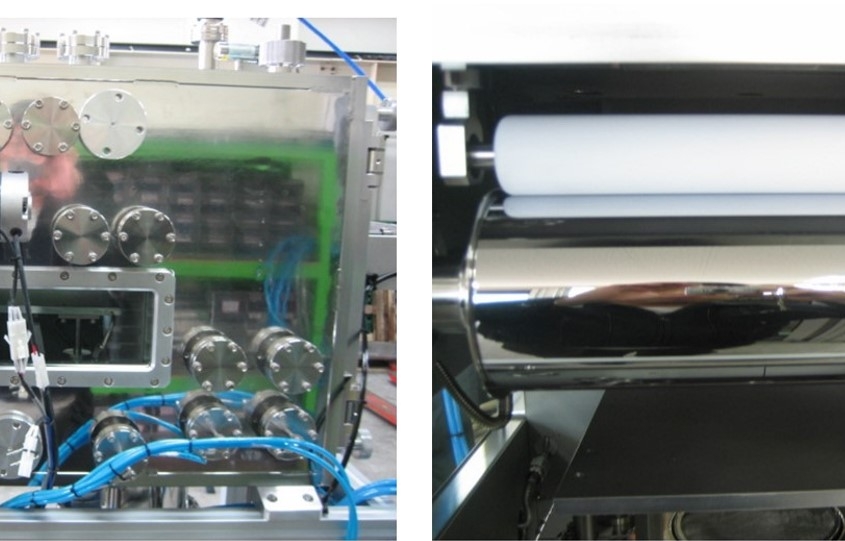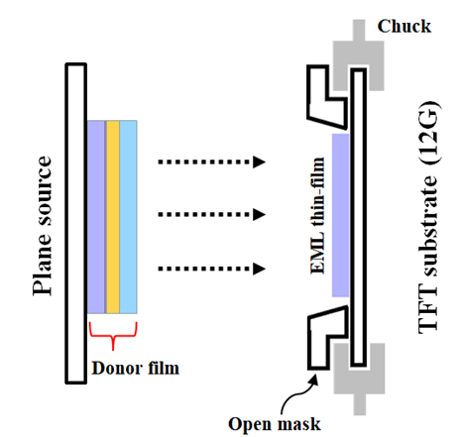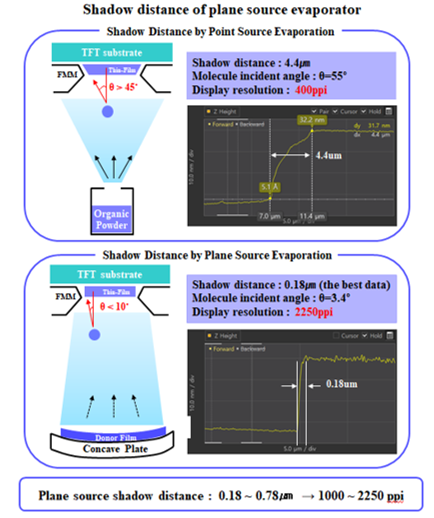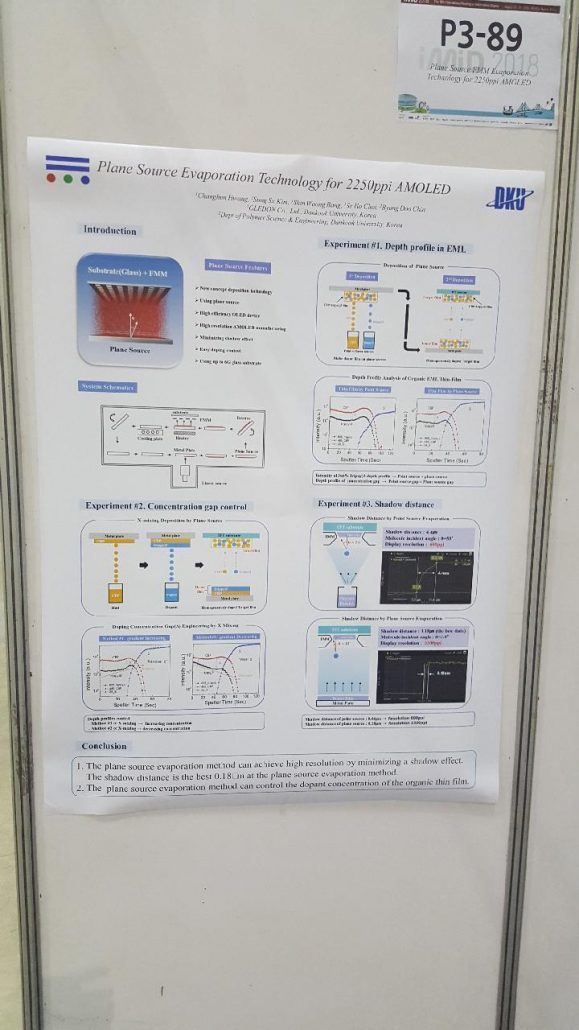글
[2022 OLED KOREA CONFERENCE] OLED의 새로운 르네상스를 시작하다
/카테고리: 디스플레이 /작성자: olednet 조남성, “OLED의 새로운 르네상스를 시작하다”, <한국디스플레이산업협회-디스플레이 CEO 인사이트> , 2022.04.14
조남성, “OLED의 새로운 르네상스를 시작하다”, <한국디스플레이산업협회-디스플레이 CEO 인사이트> , 2022.04.14
[OLEDON] OLEDON, 세계최초 10kppi 초초고해상도용 OLED증착 국산기술 개발
/카테고리: /작성자: olednet세계최초로 면소스 및 벨트면소스 증착 기술을 개발하고 있는 단국대 벤처회사인 OLEDON의 황창훈 대표는 ‘초격차’ OLED 제조 기술인 곡면소스와 벨트면소스 FMM 증착기술을 미국 산호세에서 열린 SID 2019에서 발표하여 이목을 끌었다.
곡면소스는 금속표면이 특수하게 굽어진 면소스로써, 이를 활용한 벨트면소스 FMM 증착기술은 리니어소스로 유기물을 증발하여 벨트금속면에 1차 증착한 후, 벨트금속면을 롤러이송하여 상향식 수직재증발을 하면 초미세 패턴박막을 기판에 형성 할 수 있는 개념이다.

<사진: OLEDON이 개발한 벨트면소스 증착기, source : OLEDON>
황대표는 “1058ppi의 FMM 마스크를 사용하여 미세패턴의 세도우거리를 측정하면 기존의 리니어 소스로 증착 된 패턴의 세도우거리는 2.5μm인 반면, 벨트면소스로 증착된 패턴의 세도우거리는 0.2μm으로서 이른바 ‘Shadow-free’한 초고해상도의 OLED 패턴의 제조가 가능함을 확인하였다”고 밝혔다.
또한, 황대표는 “기존 증착의 미세 원형 패턴은 중앙에서 끝 부분으로 갈수록 형상이 매우 일그러지는 반면, 벨트면소스로 증착된 박막의 패턴 형상은 그대로 유지되는 것을 확인하였다”고 소개하며, “5um 패턴폭의 2250ppi 수준의 초고해상도를 넘어 600nm 패턴폭을 가지는 10,000ppi 수준의 OLED 소자도 제작할 수 있다”고 언급하였다.
마지막으로 황대표는 “현재 수입에 의존하고 있는 OLED 증착기의 신개념 증착기술의 개발이 시급하다”고 밝히기도 하였다.

<사진: 리니어소스 패턴과 곡면소스의 패턴, source : OLEDON>
한편 OLEDON은 면소스와 벨트면소스 증착기에 대한 원천특허를 포함하여 총 30편의 면소스증착기에 관련된 특허를 보유하고 있다.

<사진: OLEDON이 보유한 면소스와 벨트면소스 증착기 원천 특허, source : OLEDON>
OLEDON, ‘초격차’ OLED 제조용 면소스 증착기술 공개
/카테고리: Exhibition, Exhibition, Exhibition, 기술 /작성자: Daejeong YOON2018년 10월 24일부터 서울 코엑스에서 열리고 있는 IMID2018에서 OLED 증착장비 개발 벤처회사인 OLEDON이 ‘경쟁 국가들과의 초격차를 유지하기 위한’ OLED 제조 기술인 면소스 증착기술을 공개하여 이목을 집중시키고 있다.
OLEDON의 황창훈대표는 “한국이 현재의 OLED 생산국 1위를 앞으로도 유지하려면 창의적인 증착 기술개발 도전에 적극 투자하여야 한다”며, “미래의 중소형 및 대형 OLED 제조는 모두 면소스 증착기술이 사용될 것”이라 전망했다.
OLEDON이 세계최초로 개발 중인 곡면소스 FMM 증착기술은 2250ppi의 AMOLED 제조가 가능한 초고해상도 OLED 증착기술로서, 미세 패턴의 섀도우거리가 0.18um까지 가능하여 11K급 초고해상도의 AMOLED 패턴공정이 가능하다.

기존의 FMM 증착 패턴(좌)와 면소스 FMM 증착 패턴(우), Source: OLEDON
황 대표는 이러한 공정을 800ppi 섀도우 마스크로 확인한 결과, 면소스로 증착한 패턴의 발광면적이 기존의 증착 방법보다 1.7배 향상되었다고 발표하였다.
한편, OLEDON은 면소스 FMM증착기술의 원천특허를 보유하고 있으며 최근에는 대면적 OLED TV 제조용 수직형 면소스증착 특허를 출원하기도 하였다.

OLED TV 제조용 수직형 면소스 증착, Source: OLEDON
OLEDON, 대형 OLED TV 제조용 수직 면소스 증착 기술 개발
/카테고리: 장비, 장비, 장비, 장비, 장비, 포커스온, 포커스온, 포커스온, 포커스온, 포커스온, 포커스온, 포커스온, 포커스온 /작성자: Daejeong YOON중소형 OLED용과 대면적 OLED용 면소스 증착 기술을 개발하고 있는 OLEDON의 황창훈 대표는 최근 77인치 이상 초대형 OLED TV의 제조가 가능한 수직형 면소스 증착 기술을 개발하고 있다고 밝혔다. 황 대표는 수직 면소스 증착 기술을 사용 시, 12세대(3300 x 4000 mm)급 대형 기판의 처짐 문제 없이 77인치 이상의 OLED TV 대량 생산이 가능하다고 관련 기술을 소개하였다.
황 대표 설명에 따르면, 기존의 인라인형 증착기로 75인치 이상의 TV의 생산 시 기판의 처짐이 심하고 다수의 리니어 소스 제어가 어려워 생산 수율이 매우 낮을 수 있다. 황 대표는 이를 해결하기 위해 새로운 개념의 12세대용 대면적 클러스터형 증착 기술이 필요하다고 밝히며, 수직 면소스 증착 기술이 적절한 대안이 될 것임을 언급하였다.
한편, OLEDON은 면소스 증착 기술의 원천특허를 보유하고 있으며, 고해상도 AMOLED 제조용 곡면소스 FMM 증착과 대면적 OLED TV 제조용 수직 면소스 증착 기술과 관련 된 특허를 출원하였다.

[IMID 2018] OLEDON, 2250ppi AMOLED 제조용 곡면소스 FMM 증착기술 세계최초로 개발
/카테고리: 기술, 기술, 기술, 기술, 기술 /작성자: olednet고해상도 AMOLED 제조용 면소스 증착기술을 개발하고 있는 OLEDON의 황창훈 대표는 2250ppi의 AMOLED 화소의 증착이 가능한 곡면 소스 FMM 증착기술을 세계 최초로 개발하였다고 IMID 2018에서 발표했다.
기존의 리니어 소스 FMM 증착기술은 섀도우거리가 3 um으로서 생산 가능한 AMOLED의 해상도는 570ppi 수준이다. 반면, OLEDON에서 이미 선보인 바 있는 면소스 증착기술은 섀도우거리가 0.8~1.5 um 으로서 AMOLED의 해상도를 800~1200ppi까지 구현할 수 있다. 한편, 이번에 새로 개발된 곡면소스 FMM 증착기술은 섀도우거리가 0.18~0.6 um로서 AMOLED의 최대 해상도를 2250ppi까지 구현 가능한 면소스 증착기술의 업그레이드 기술이다.

원리는 오목거울을 통해 빛을 모으는 것처럼, 기존의 평평한 면 소스에 곡면을 가해 발광재료가 퍼지지 않고 원하는 곳에 정확히 증착 되어 섀도우 거리를 줄일 수 있는 방식이다.
이 기술이 상용화 된다면 mobile 기기 뿐만 아니라 가상현실 기기 등 폭넓게 적용될 수 있을 것으로 기대를 모으고 있다.

[SID 2018] OLEDON, presented about X-mixing plane source deposition technology for AMOLED efficiency enhancement.
/0 코멘트/카테고리: Uncategorized, Uncategorized, Uncategorized /작성자: OLEDNETIn SID 2018, Hwang Chang-Hoon, CEO of OLEDON, announced a new plane source FMM deposition technology that can produce ultra-high resolution AMOLED of 2,250 ppi.
According to the announcement, the linear source currently applied to mass production has a problem of causing superimposition of fine adjacent patterns in a high resolution implementation due to a shadow distance of 3 μm. But Hwang said he succeeded in reducing the shadow distance of the patterns by 0.18 um using plane source, which is the smallest shadow distance ever introduced.

<Shadow effect comparison between current process and the process applied with the plane source, Source: OLEDON>
Hwang added that he developed ‘X-mixing’ technology in which the host and dopant thin films were separately deposited on the metal surface and then the host molecules and dopant molecules were automatically diffused through the plane evaporation to form the light emitting layer. Hwang commented, “It is not easy to control the composition of the dopant by using the linear source evaporation technology, which vaporizes the host material and the dopant material at the same time. However, since X-mixing technology can control the composition, it is possible to achieve a material utilization rate up to 4 times higher than the conventional method.”

<SIMS data comparison between the emitting layer deposited by conventional method and the emitting layer deposited by the plane source, Source: OLEDON>

<Dopant gradient data of the emitting layer applied with X-mixing technology, Source: OLEDON>
Hwang said, “In case of green OLED produced by X-mixing technology, 40% improvement in the emitting efficiency was verified, compared to the existing technology. OLEDON is currently under development of the optimized X- mixing development for forming exciton and the mask aligner with new concept sub-micron precision.

<Luminance data for green OLED produced by X-mixing technology and green OLED produced by the conventional method, Source: OLEDON>
Finally, Mr. Hwang mentioned that based on the development results, he plans to install a plane source FMM evaporator capable of manufacturing ultra-high resolution micro OLED devices in Dankook University. (Reference: OLEDON homepage: www.oledon.co.kr)
[SID 2018] OLEDON, AMOLED 효율 향상용 X-mixing 면소스 증착 기술 발표
/0 코멘트/카테고리: /작성자: OLEDNETSID 2018에서 OLEDON의 황창훈 대표는 2,250ppi의 초고해상도 AMOLED를 제작 할 수 있는 새로운 면소스 FMM 증착기술을 발표했다.
발표에 따르면, 현재 양산에 적용 중인 리니어 소스는 3um의 섀도우 거리(shadow distance)로 인해 고해상도 구현 시 미세 인접 패턴들의 중첩을 발생시키기는 문제가 발생한다. 하지만 황대표는 면소스를 이용해 패턴들의 섀도우 거리를 0.18 um까지 줄이는데 성공하였다고 밝혔으며, 이는 현재까지 발표 된 섀도우 거리 중 가장 최소의 섀도우 거리라고 설명했다.

<기존 공정과 면소스를 이용한 공정의 섀도우현상(shadow effect) 비교, Source: OLEDON>
아울러 황대표는 호스트박막과 도판트박막을 따로 금속면에 증착 한 후 면증발을 통해 호스트 분자와 도판트 분자가 자동 확산되어 발광층이 형성되는 ‘X-mixing’기술을 개발하였다고 발표하였다. 황대표는 “기존 기술인 호스트 물질과 도판트 물질을 동시에 기화되는 리니어 소스 증착기술로는 도판트의 조성 제어가 쉽지 않으나, X-mixing 기술은 조성 제어가 자유자재로 가능하기 때문에 기존 대비 4배까지 향상 된 물질 사용률 달성이 가능하다”고 밝혔다.

<기존방식으로 증착 된 발광층과 면소스로 증착 된 발광층의 SIMS 데이터, Source: OLEDON>

<X-mixing 기술로 얻은 발광층의 dopant gradient 데이터, Source: OLEDON>
황대표는 “X-mixing 기술로 제작한 green OLED의 경우 기존 기술보다 40% 향상 된 발광효율을 확인하였다”고 언급하며 “OLEDON은 현재 소자의 발광효율향상을 목적으로 엑시톤형성의 최적화 된 X-mixing 개발과 신개념의 sub-micron 정밀도를 지닌 mask aligner를 개발 중”이라고 밝혔다.

<X-mixing 기술로 제작 된 green OLED와 기존 방식으로 제작 된 green OLED의 발광 데이터, Source: OLEDON>
마지막으로 황대표는 이번 개발결과를 토대로 초고해상도 마이크로 OLED 소자의 제조가 가능한 연구용 면소스 FMM 증착기를 단국대학교내에 설치할 계획이라고 언급했다. (참고:OLEDON사의 홈페이지 www.oledon.co.kr)
[IMID 2017] Opening solution for next generation high-resolution OLED implementation
/0 코멘트/카테고리: Uncategorized /작성자: OLEDNETVarious solutions for high resolution OLED implementation were released at iMiD 2017 held in COEX from October 18th to 19th. As the resolution of small and mid-sized OLEDs, which are currently being commercialized, is staying at the QHD level, the solutions released at this time have attracted a great deal of attention from display members.
First, Hwang Chang-hoon, CEO of OLEDON, who is developing plane source FMM deposition technology, announced at the business forum, “The plane source FMM deposition technology currently being developed is the only alternative for ultra-high resolution OLED manufacturing at 2,250 ppi”. Hwang Chang-hoon CEO said, “We measured the shadow distance using a-step, and it was 0.38 μm. We can fabricate OLED device with 2,250 ppi only if we have this shadow distance.” “We are currently looking for shadow-free process conditions”

<Difference in shadow distance between point source and plane source>
In addition, Hwang Chang-hoon said, “We first co-deposited the host material and the dopant material on the metal plate to evaporate the deposited green donor thin film and measure the green target thin film with the same PL wavelength for the first time” and “Color control of target thin films made with plate sources can be controlled by the amount of dopant molecules in the donor film, so color control is expected to be easy”.

<OLEDON plane evaporation co-deposition material>
AP Systems, which recently announced the successful development of 1,000 ppi FMM using ultra-short pulse laser (USPL), exhibited 5.28 inch FMM of 825 ppi and 4.72 inch FMM of 677 ppi at this exhibition. A company official said, “By developing a burr-free laser process to solve the burr problem caused by the heat generated during the fabrication process, it is possible to fabricate not only FMM of 1170 ppi but also FMM of various shapes”.

<5.28 inch 825ppi FMM of AP Systems>
Finally, Philoptics unveiled FMMs fabricated using electro forming, especially, FMM of 1,200 ppi, which attracted attention this time, was displayed separately in the VIP room. A company official said “We have secured the stability of the process for the production of 1,200 ppi FMM,” and mentioned “We plan to deliver it to panel makers for testing in the first half of next year, and aim to develop FMM at 2,000 ppi later.”

<FMM of Philoptics manufactured by electro forming method>
As such, in this iMiD 2017, various solutions for high-resolution patterning of OLEDs has been released. Recently, as the number of contents requiring high-resolution OLED such as virtual reality contents increases, interest of smartphone users are increasingly interested. It is worth noting which solution will enable the small to medium-sized UHD OLED era.
[IMID 2017] 차세대 고해상도 OLED 구현을 위한 solution 대거 공개
/0 코멘트/카테고리: Exhibition, 포커스온 /작성자: OLEDNET지난 10월 18일부터 19일까지 코엑스에서 열린 iMiD 2017에서 고해상도 OLED 구현을 위한 다양한 solution들이 공개 됐다. 현재 상용화 되고 있는 중소형 OLED의 해상도가 QHD급에서 머물고 있는 만큼 이번에 공개 된 solution들은 디스플레이 관계자들에게 큰 주목을 받았다.
먼저, 면소스 FMM 증착 기술을 개발 중인 OLEDON의 황창훈 대표는 business forum에서 “2,250 ppi의 초고해상도 OLED 제조를 위해서는 현재 개발 중인 면소스 FMM 증착기술이 유일한 대안”이라고 발표하였다. 황창훈 대표는 “a-step을 이용하여 shadow distance를 측정한 결과 0.38 um였으며, 이러한 shadow distance를 가져야 비로소 2,250 ppi의 OLED 소자 제작이 가능하다”라며 “현재 shadow-free한 공정 조건을 찾고 있다”라고 밝혔다.

<포인트소스와 면소스의 shadow distance 차이>
또한, 황창훈 대표는 “호스트 물질과 도판트 물질을 금속면에 co-deposition하여 증착된 그린 도너박막을 재증발하여 동일한 PL 파장을 가지는 그린 타겟박막을 최초로 측정하였다”며 “면소스로 제작한 타겟박막의 칼라 제어는 도너박막의 도판트 분자의 양으로 조절이 가능하기 때문에 색 조절이 쉬울것으로 예상된다”라고 밝혔다.

<OLEDON의 면증발 co-deposition 자료>
한편, 최근 USPL(ultra-short pulse laser)을 이용하여 1,000 ppi FMM 개발에 성공했다고 발표한 AP Systems는 이번 전시회에서 825 ppi의 5.28 inch FMM와 677 ppi의 4.72 inch FMM을 전시했다. 업체관계자는 “burr-free laser process를 개발하여 제작 공정 시 발생하는 열로 인한 burr 문제를 해결하였으며, 이러한 방식으로 1170 ppi의 FMM 뿐만 아니라 다양한 형태를 갖는 FMM도 제작이 가능하다”고 언급했다.

<AP Systems의 5.28 inch 825ppi FMM>
마지막으로 Philoptics는 전해주조(electro forming)을 이용하여 제작 된 FMM들을 공개하였으며, 특히 이번에 주목받은 1,200 ppi의 FMM은 VIP room에 따로 전시하였다. 업체 관계자는 “현재 1,200 ppi FMM 제작을 위한 공정의 안정성도 확보했다”고 밝히며 “내년 상반기에 test용으로 패널 업체에 납품 예정이며 추후에 2,000 ppi 수준의 FMM을 개발하는 것이 목표”라고 언급했다.

<전해주조 방식으로 제작 된 Philoptics의 FMM>
이처럼 이번 iMiD 2017에서는 OLED의 고해상도 패터닝을 위한 다양한 solution이 공개 됐다. 최근 들어 가상현실 컨텐츠 등 고해상도 OLED가 필요한 컨텐츠들이 증가함에 따라 스마트폰 사용자들의 관심도 점점 고조되고 있다. 중소형 UHD OLED 시대는 어느 solution에 의해 개화 될지 귀추가 주목된다.
초고화질 해상도(UHD)의 OLED 스마트폰 시대 열릴까
/0 코멘트/카테고리: 세트, 시장 /작성자: OLEDNET최근 스마트폰 기기를 통한 VR 컨텐츠 체험이 증가하는 추세로 인해 고해상도 스마트폰이 요구되고 있으나, 2014년 Galaxy Note4에 최초로 QHD OLED가 적용된 이후 3년 동안 OLED 스마트폰의 해상도는 여전히 QHD급에 머물고 있다.
OLED 스마트폰의 해상도를 결정하는 핵심은 발광층의 증착 공정이다. 현재 적용 되고 있는 상향식 증착 방식은 기판과 FMM(fine metal mask)를 수평으로 하여 증착 장비 상부에 배치한 뒤 하부의 리니어 소스에서 유기물을 증발시켜 RGB 발광층을 형성하는 방식이다.
UHD급 이상의 고해상도 OLED를 제조하기 위해서는 15um 두께 이하의 얇은 FMM이 필요하나 FMM이 얇아질수록 patterning, 인장, 용접등의 기술적인 이슈가 발생하여 양산적용이 어렵다.
이러한 문제들을 극복하기 위해 수직형 증착과 면소스 증착, 다양한 metal mask patterning 기술들이 개발되고 있다.
기판과 FMM를 수직으로 배치하는 수직형 증착기는 일본의 Hitachi에서 최초로 개발하였으며, Canon tokki도 Finetech Japan 2013에서 6세대 수직 증착 방식의 장비를 공개한바 있으나 현재 양산에 적용되고 있진 않다.

<Finetech Japan 2013에서 공개 된 Canon tokki의 Gen6 vertical type evaporator>
하지만 최근 전자신문에 따르면 Applied Materials에서 6세대 flexible OLED용 수직 증착 방식의 증착 장비를 개발했다고 밝혔으며, 일본의 Japan Display에서 test 중이라고 언급한바 있다.
리니어소스가 아닌 면소스를 이용한 증착 방식도 검토되고 있다. 면소스 증착 방식은 유기물을 금속면에 1차로 증착하여 면소스를 만든 후, 이를 재증발시켜 기판에 유기물 박막을 형성하는 원리로써 지난 iMiD 2017에서 OLEDON의 황창훈 대표는 면소스 증착 방식을 통해 2250 ppi의 고해상도 OLED 구현이 가능하다고 언급하였다.
Metal Mask patterning 기술로는 전주도금(electro forming)과 laser patterning 기술이 주로 거론되고 있다. 전주도금 방식은 Wave Electornics와 TGO Technology, Athene등의 업체에서 개발하고 있으며, laser patterning 기술은 AP Systems에서 개발중에 있다.
이처럼 다양한 관점에서 진행되고 있는 고해상도 OLED 구현을 위한 개발이 현재의 문제를 극복하고 OLED 스마트폰의 UHD 해상도 구현에 기여할 수 있을지 많은 관심이 집중되고 있다.

<OLEDON사가 개발한 면소스 증착 기술 원리>
Is there possibility of High resolution(UHD) OLED Smart-phone generation?
/0 코멘트/카테고리: /작성자: OLEDNETRecently VR contents experience through smart-phone device has been increased, therefore high resolution of smart phone is becoming necessary. However, OLED smart-phone resolution still remains at QHD level for 3 years since QHD OLED is applied to Galaxy Note 4 for the first time in 2014.
The core point that decides resolution of OLED smart-phone is evaporation process for emission layer. Bottom-up type evaporation method, which is applied to the recent devices is that substrate and FMM (fine metal mask) are horizontally arranged on the upper side of evaporator and vaporize the organic material from the lower linear source in order to form RGB layer.
Thin FMM measures less than 15um thick is necessary for making high resolution OLED like UHD level, however, as FMM gets thinner, it would be difficult to make mass production because technical problems will be occurred such as patterning, sealing and welding.
In order to solve these problems, various metal mask patterning technologies are being developed such as vertical type evaporation and plane source evaporation.
Vertical type evaporator that arranges board and FMM vertical is developed by Hitachi of Japan for the first time. And Canon Tokki exhibited Gen6 vertical type evaporator at Finetech Japan 2013, however it is not being used for mass production at the moment.

<Canon Tokki’s Gen6 vertical type evaporator which is exhibited at Finetech Japan 2013>
According to the recent ETNEWS, Applied Materials developed Gen6 flexible OLED vertical type evaporator and it is being tested in Japan Display.
Plane source evaporator is being tested but also the linear source type. Plane source evaporator method is that an organic material is first evaporated on the metal surface to produce plane source, then re-evaporated in order to form an organic thin film on the substrate.
In the past iMiD 2017, representative of OLEDON, Chang Hoon Hwang mentioned that 2250 ppi resolution OLED can be implemented through plane source evaporator.
For metal mask patterning technology, electro forming and laser patterning technology is highlighted. Electro forming method is developed by Wave Electronics, TGO Technology, Athene and so on. Laser patterning technology is being developed by AP Systems.
As such, development for high resolution OLED is receiving great attention whether it can solve the current problems and contribute to UHD resolution implementation for OLED smart-phone.

<Principle of plane source evaporation developed by OLEDON>
OLEDON, Find the future of AMOLED in plane source FMM!
/0 코멘트/카테고리: /작성자: OLEDNETThree years have passed since the first QHD (about 515 ppi) OLED applied to Galaxy Note4 in 2014, but OLED resolution is still in QHD. In order to manufacture high-resolution OLED over UHD, FMM of less than 15 μm is required, but it is not applied to mass production due to various technical issues.
Professor Hwang Chang-Hoon, CEO of OLEDON, a venture business of Dankook University, proposed that the plane source FMM deposition technology is the only solution for a high-resolution OLED manufacturing process over UHD at the 1H semester UBI Research Seminar “OLED Market Analysis and Latest Technology” held on June 30 (Fri) at Yeouido FKI Conference Center.
Professor Hwang Chang-Hoon said, “To improve the resolution of AMOLED, the angle of flight of organic molecules should be reduced to less than 10 degrees and the aspect ratio of TFT devices should be maintained at 1.0 level.” and explained “The evaporation angle (incidence angle) of the currently known linear source is about 40 degrees, and the shadow distance is about 3 um. Therefore, the ratio of the pattern width, the shadow distance, and the aspect ratio can be increased at the SUHD level AMOLED patterning process. Ultimately, the current patterning technology loses the flatness of the film. “.
In addition, Professor Hwang Chang-Hoon said, “Linear deposition technology has limitations in achieving resolution higher than QHD, and development of plane source FMM deposition technology is the only way to manufacture OLED with 2000 ppi or higher.”.

<Professor Hwang Chang-Hoon announced the 2250ppi AMOLED technical problem, Source: the 1H semester UBI Research Seminar>
The shadow distance measured by OLEDON’s plane source FMM deposition technique ranges from 0.68 to 1.05 μm and the angle of incidence is 13 to 19 degrees and converting this result to resolution makes it possible to fabricate a device with a maximum of 1500 ppi. On the other hand, with the newly developed Xplane source, the shadow distance was 0.38 ~ 0.56um and the incident angle was 7.2 ~ 8.0 degrees, it is possible to manufacture up to 3300 ppi device by converting it to the resolution. In the last SID2017, Prof. Jin Byung-Doo and Prof. Hwang Chang-Hoon introduced the world’s first measurement of sub-micron-scale shadow distance using plane source patterning technology, it has been announced that it is possible to manufacture a micro AMOLED device having a Super Ultra (SUHD) resolution of 11K (2250 ppi) or more if scale-up development is applied to large-area OLED display production industry in the future. (Paper title: Plane source evaporation techniques for Super ultra high resolution flexible AMOLED)

Sub-micron Shadow data and incident angle data obtained by plane source FMM deposition technology, Source: the 1H semester UBI Research Seminar
On the other hand, based on the development results, OLEDON announced that it plans to develop and install planar source FMM evaporator for research, which can manufacture ultra-high resolution micro OLED devices using plane source deposition technology, in Dankook University. (Refer to: OLEDON homepage www.oledon.co.kr)
OLEDON, AMOLED의 미래를 면소스 FMM에서 발견하다!
/0 코멘트/카테고리: 장비 /작성자: OLEDNET2014년 Galaxy Note4에 최초로 QHD (약 515 ppi) OLED가 적용된 이후 3년이 흘렀지만 OLED의 해상도는 아직 QHD급에 머물고 있다. UHD 이상의 고해상도 OLED 제조를 위해서는 15um 이하의 FMM이 필요하지만 다양한 기술적인 이슈로 양산에 적용되고 있지 못한 상황이다.
6월 30일 여의도 전경련 회관에서 개최된 유비산업리서치의 “상반기 결산세미나 : OLED 시장분석과 최신기술”에서 단국대학교의 실험실 벤처 OLEDON 대표인 황창훈 교수는 plane source FMM 증착기술이 UHD 이상의 고해상도 OLED 제조를 위한 유일한 해법이라고 제시하였다.
황창훈 교수는 “AMOLED의 해상도를 향상하려면, 유기물 분자의 비행각도를 10도 미만으로 줄여야하고, TFT 소자의 종횡비(Aspect Ratio)를 1.0수준으로 유지해야 한다.” 라며, “현재 알려진 리니어소스의 증발각도(입사각)는 약 40도이며, 이에 따른 셰도우 거리는 약 3um로 SUHD수준의 AMOLED 패터닝 공정시 패턴폭과 셰도우거리의 비율, aspect ratio가 증가할 수 밖에 없다. 결국 현재의 패터닝 기술로는 박막의 평판도를 잃게 된다.” 라고 설명했다.
또한, 황창훈 교수는 “리니어소스 증착기술로는 QHD 이상의 해상도 구현에 한계가 있으며, plane source FMM 증착기술 개발만이 2000ppi 이상의 OLED를 제조할 수 있는 유일한 해법이다”고 강조하였다.

<황창훈 교수가 발표한 2250ppi AMOLED 기술적 문제점, 출처 : UBI 상반기 결산세미나>
OLEDON사의 plane source FMM 증착기술로 측정한 셰도우거리는 0.68~1.05um, 입사각은 13~19도를 얻을 수 었으며, 이 결과를 해상도로 환산하면 최대 1500ppi 소자 제작이 가능하다. 한편, 새로 개발된 Xplane source로는 셰도우거리 0.38~0.56um, 입사각은 7.2~8.0도를 얻을 수 있었으며, 이를 해상도로 환산하면 최대 3300ppi 소자 제작이 가능하다. 지난 SID2017에서도, 진병두교수와 황창훈 교수팀은 plane source 패터닝 증착기술을 사용하여 세계최초로 측정한 서브마이크론 스케일의 셰도우거리 결과를 소개하였으며, 향후 스케일업 개발을 통하여 대면적 OLED 디스플레이 생산산업에 응용될 경우 11K급 (2250ppi) 이상의 수퍼울트라(SUHD) 해상도를 가지는 마이크로 AMOLED소자의 제조가 가능하다고 발표한바 있다. (논문제목: Plane source evaporation techniques for Super ultra high resolution flexible AMOLED)

<plane source FMM 증착기술로 얻은 sub-micron 셰도우 데이터와 입사각 데이터 , 출처 : UBI 상반기 결산세미나>
한편, OLEDON사는 이번 개발결과를 토대로, plane source 증착기술을 활용한 초고해상도 마이크로 OLED 소자의 제조가 가능한 연구용 plane source FMM 증착기를 단국대학교내에 개발 설치할 계획이라고 밝혔다. (참고:OLEDON사의 홈페이지 www.oledon.co.kr)
국문 풋터
OLEDNET의 모든 콘텐츠(영상, 기사, 사진)는 저작권법의 보호를 받은 바, 무단 전재, 복사, 배포 등을 금합니다. Copyright ⓒ 2013 by OLEDNET. All rights reserved.











